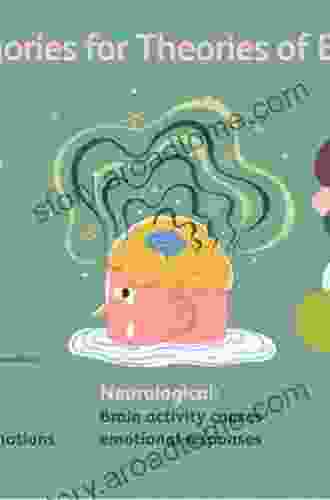The Biology and Psychology of Emotions: Unveiling the Enigma of Human Feelings

Emotions are an integral part of human experience, shaping our perceptions, thoughts, and actions. They can be as fleeting as a momentary twinge or as enduring as a deeply rooted passion. For centuries, philosophers and scientists have pondered the nature of emotions, seeking to unravel their enigmatic qualities.
4.5 out of 5
| Language | : | English |
| File size | : | 1959 KB |
| Text-to-Speech | : | Enabled |
| Enhanced typesetting | : | Enabled |
| Word Wise | : | Enabled |
| Print length | : | 411 pages |
| Screen Reader | : | Supported |
In the past few decades, significant strides have been made in understanding the biology and psychology of emotions. Researchers have pinpointed specific brain regions and neurochemicals involved in emotional processing, while psychologists have explored the cognitive and behavioral components that shape our emotional experiences.
The Biological Underpinnings of Emotions
At the core of our emotional lives lies a complex network of biological systems. The nervous system, which consists of the brain, spinal cord, and peripheral nerves, plays a crucial role in detecting and transmitting emotional signals.
When we encounter an emotionally evocative stimulus, such as the sight of a loved one or the sound of a jarring noise, sensory receptors in our body transmit signals to the brain. These signals are then processed by various brain structures, including the amygdala, hippocampus, and prefrontal cortex.
The amygdala, often referred to as the "emotional brain," is responsible for rapidly detecting and evaluating threats and opportunities. It activates the sympathetic nervous system, which triggers physiological responses such as increased heart rate and respiration, preparing the body for fight or flight.
The hippocampus, on the other hand, is involved in memory and context processing. It helps us to recall past emotional experiences and integrate them with current situations, shaping our emotional responses.
The prefrontal cortex, located at the front of the brain, plays a key role in regulating emotions. It helps us to inhibit impulsive behaviors, make rational decisions, and engage in cognitive reappraisal, which involves reinterpreting negative events in a more positive light.
In addition to the nervous system, hormones also play a significant role in emotional regulation. Hormones are chemical messengers that are released by endocrine glands into the bloodstream. Some hormones, such as cortisol, are associated with stress and anxiety, while others, such as oxytocin, promote bonding and social behavior.
The Psychology of Emotions
While biology provides the foundation for our emotional experiences, psychology offers insights into the cognitive and behavioral processes that shape them. Emotion is not merely a passive reaction to external stimuli but an active and dynamic process influenced by our thoughts, beliefs, and social context.
Cognitive appraisal theory, proposed by psychologist Richard Lazarus, suggests that emotions are triggered by our subjective evaluation of situations. According to this theory, the way we interpret an event determines the emotional response we experience. For example, if we perceive a situation as threatening, we may feel fear or anxiety, while if we perceive it as a challenge, we may feel excitement or determination.
Emotions are also influenced by our social interactions. We learn about emotions through observing others and by receiving feedback from the people around us. Our culture and society shape our emotional norms, influencing what emotions are considered appropriate or desirable in different situations.
Emotion regulation refers to the ability to manage and control our emotional responses. This involves both cognitive and behavioral strategies, such as cognitive reappraisal, seeking support from others, or engaging in stress-reducing activities.
Emotions are complex and multifaceted phenomena that involve both biological and psychological processes. By understanding the intricate interplay between these two domains, we can gain a deeper appreciation for the enigmatic nature of human feelings.
The Biology and Psychology of Emotions offers a comprehensive exploration of this fascinating field, providing readers with a comprehensive overview of the latest scientific findings and insights. This book is an invaluable resource for anyone interested in unraveling the mysteries of the human psyche and gaining a deeper understanding of the intricate world of emotions.
4.5 out of 5
| Language | : | English |
| File size | : | 1959 KB |
| Text-to-Speech | : | Enabled |
| Enhanced typesetting | : | Enabled |
| Word Wise | : | Enabled |
| Print length | : | 411 pages |
| Screen Reader | : | Supported |
Do you want to contribute by writing guest posts on this blog?
Please contact us and send us a resume of previous articles that you have written.
 Book
Book Novel
Novel Page
Page Chapter
Chapter Text
Text Story
Story Genre
Genre Reader
Reader Library
Library Paperback
Paperback E-book
E-book Magazine
Magazine Newspaper
Newspaper Paragraph
Paragraph Sentence
Sentence Bookmark
Bookmark Shelf
Shelf Glossary
Glossary Bibliography
Bibliography Foreword
Foreword Preface
Preface Synopsis
Synopsis Annotation
Annotation Footnote
Footnote Manuscript
Manuscript Scroll
Scroll Codex
Codex Tome
Tome Bestseller
Bestseller Classics
Classics Library card
Library card Narrative
Narrative Biography
Biography Autobiography
Autobiography Memoir
Memoir Reference
Reference Encyclopedia
Encyclopedia Thomas F Derosa
Thomas F Derosa Madeleine Pownall
Madeleine Pownall Linda Booysen
Linda Booysen Spring West
Spring West Tony Batchelor
Tony Batchelor Sarah R Painter
Sarah R Painter Victor O Sheftel
Victor O Sheftel Lynnette Porter
Lynnette Porter Z Maekawa
Z Maekawa Michael V Marriott
Michael V Marriott Wade E Pickren
Wade E Pickren Will Johnson
Will Johnson Roma Downey
Roma Downey Michael P Peterson
Michael P Peterson M K Agarwal
M K Agarwal Lucy Collin
Lucy Collin Shannon Johnson
Shannon Johnson Madison Pierce
Madison Pierce Thomas Aquinas
Thomas Aquinas Ruth B Purtilo
Ruth B Purtilo
Light bulbAdvertise smarter! Our strategic ad space ensures maximum exposure. Reserve your spot today!

 Travis FosterDevelopment, Characterization, and Applications: Unlocking the Potential of...
Travis FosterDevelopment, Characterization, and Applications: Unlocking the Potential of...
 D'Angelo CarterUnveiling the Microscopic World: NMR Crystallography – A Comprehensive Guide...
D'Angelo CarterUnveiling the Microscopic World: NMR Crystallography – A Comprehensive Guide... Alex FosterFollow ·5.8k
Alex FosterFollow ·5.8k Dylan HayesFollow ·14.8k
Dylan HayesFollow ·14.8k H.G. WellsFollow ·5.8k
H.G. WellsFollow ·5.8k Liam WardFollow ·5.2k
Liam WardFollow ·5.2k Raymond ParkerFollow ·10.8k
Raymond ParkerFollow ·10.8k Levi PowellFollow ·13.1k
Levi PowellFollow ·13.1k Keith CoxFollow ·9.6k
Keith CoxFollow ·9.6k Arthur C. ClarkeFollow ·10.1k
Arthur C. ClarkeFollow ·10.1k

 E.M. Forster
E.M. ForsterThe Real Blueprint to Short-Term Rental Success
Are you ready to create a...

 Mark Mitchell
Mark MitchellMidas Touch: The Astrology Of Wealth
Are you ready to tap into the cosmic forces...

 Grant Hayes
Grant HayesPrecarious Creativity: Unpacking the Global Media and...
In the ever-evolving landscape of the...

 Cameron Reed
Cameron ReedGuru Govind Singh: A Life of Courage and Inspiration for...
Guru Govind Singh, the tenth Sikh guru,...

 Yukio Mishima
Yukio MishimaCastles & Shapes: The Enchanting World of Ris...
In the realm of...

 Jerome Blair
Jerome BlairGolden Keys To Jyotisha Volume Ten: The Ultimate Guide to...
Embark on an...
4.5 out of 5
| Language | : | English |
| File size | : | 1959 KB |
| Text-to-Speech | : | Enabled |
| Enhanced typesetting | : | Enabled |
| Word Wise | : | Enabled |
| Print length | : | 411 pages |
| Screen Reader | : | Supported |








